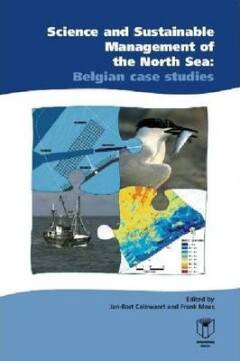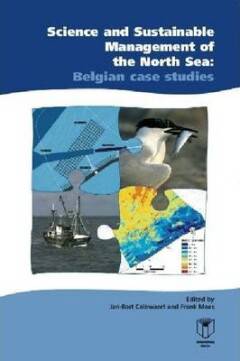
- Afhalen na 1 uur in een winkel met voorraad
- Gratis thuislevering in België vanaf € 30
- Ruim aanbod met 7 miljoen producten
- Afhalen na 1 uur in een winkel met voorraad
- Gratis thuislevering in België vanaf € 30
- Ruim aanbod met 7 miljoen producten
Zoeken
Science and Sustainable Management of the North Sea
Belgian Case Studies
Jan-Bart Calewaert, Frank Maes
Boek | Engels
€ 46,86
+ 93 punten
Omschrijving
This book contains contributions from four Belgian marine research projects relevant for the sustainable management of the Belgian Part of the North Sea (BPNS). Important results and research experiences are presented in four case studies. The leitmotiv throughout the publication is the relevance of these projects as to their potential to support a policy focussing on sustainable North Sea management. This publication provides insight into these research projects by reporting in a scientifically sound but accessible way. It is intended for all researchers working on North Sea related topics as well as for end-users and decision makers alike.
The presented case studies result from four projects funded by Belgian Science Policy (Belspo) within the framework of the second phase of the Scientific Support Plan for a Sustainable Development Policy (SPSD II): TROPHOS, BALANS, GAUFRE and MAREBASSE. These four research projects clustered within SUMANOS (2004-2006) are – with respect to contents as well as methodology – interlinked and sometimes overlapping. TROPHOS and MAREBASSE are projects in which scientific baseline information is further collected, updated and refined. They both go beyond the structural level and try to frame the gathered data within dynamic and functional processes and interactions. The MAREBASSE project (Management, Research and Budgeting of Aggregates in Shelf Seas related to End-users) focused on the physical environment with a clear emphasis on sediments and their dynamic nature. The TROPHOS project (Higher Trophic Levels in the Southern North Sea), on the other hand, zoomed in on processes structuring the higher trophic levels in the North Sea ecosystem and therefore deals with biological communities and their structuring food web interactions. Benthos, nekton and avifauna were at the core of the research, with a clear reference to dynamic aspects such as dispersal mechanisms, population dynamics and trophic interactions. GAUFRE and BALANS on the other hand are projects that are strongly directed towards policy support. The GAUFRE project (Towards a Spatial Structure Plan for Sustainable Management of the Sea) formulated a first proposal for an optimal allocation of all user functions in the BPNS by developing visions and scenarios that contribute to a spatial structure plan (SSP) of the BPNS. This is based upon a synthesis of the available scientific knowledge on user functions in the BPNS, on possible impacts of users upon each other and the environment, and on newly introduced user functions (e.g. offshore wind mills). The BALANS project (Balancing Impacts of Human Activities in the North Sea) on the other hand, developed a first conceptual balancing model “Sustainable Management of the North Sea” for policy makers and those involved in activities in the BPNS. BALANS is a policy tool for fisheries and sand and gravel extraction in the BPNS, correlating and balancing ecological, social and economic components of sustainable development through the elaboration of indicators.
In this publication, the case studies are presented and discussed in relation to their general “contribution towards a sustainable management of the North Sea”, while the authors were instructed to address or illustrate a number of specific characteristics or key-issues (e.g. involvement with stakeholders, interaction with EU level research, interdisciplinary approaches, …). Finally, a concluding chapter presents a summary of the most important findings of the partners and a selection of international experts related to the case studies, as well as recommendations and suggestions to support a common vision for future scientific research in support of an improved management policy for the BPNS and the North Sea.
The presented case studies result from four projects funded by Belgian Science Policy (Belspo) within the framework of the second phase of the Scientific Support Plan for a Sustainable Development Policy (SPSD II): TROPHOS, BALANS, GAUFRE and MAREBASSE. These four research projects clustered within SUMANOS (2004-2006) are – with respect to contents as well as methodology – interlinked and sometimes overlapping. TROPHOS and MAREBASSE are projects in which scientific baseline information is further collected, updated and refined. They both go beyond the structural level and try to frame the gathered data within dynamic and functional processes and interactions. The MAREBASSE project (Management, Research and Budgeting of Aggregates in Shelf Seas related to End-users) focused on the physical environment with a clear emphasis on sediments and their dynamic nature. The TROPHOS project (Higher Trophic Levels in the Southern North Sea), on the other hand, zoomed in on processes structuring the higher trophic levels in the North Sea ecosystem and therefore deals with biological communities and their structuring food web interactions. Benthos, nekton and avifauna were at the core of the research, with a clear reference to dynamic aspects such as dispersal mechanisms, population dynamics and trophic interactions. GAUFRE and BALANS on the other hand are projects that are strongly directed towards policy support. The GAUFRE project (Towards a Spatial Structure Plan for Sustainable Management of the Sea) formulated a first proposal for an optimal allocation of all user functions in the BPNS by developing visions and scenarios that contribute to a spatial structure plan (SSP) of the BPNS. This is based upon a synthesis of the available scientific knowledge on user functions in the BPNS, on possible impacts of users upon each other and the environment, and on newly introduced user functions (e.g. offshore wind mills). The BALANS project (Balancing Impacts of Human Activities in the North Sea) on the other hand, developed a first conceptual balancing model “Sustainable Management of the North Sea” for policy makers and those involved in activities in the BPNS. BALANS is a policy tool for fisheries and sand and gravel extraction in the BPNS, correlating and balancing ecological, social and economic components of sustainable development through the elaboration of indicators.
In this publication, the case studies are presented and discussed in relation to their general “contribution towards a sustainable management of the North Sea”, while the authors were instructed to address or illustrate a number of specific characteristics or key-issues (e.g. involvement with stakeholders, interaction with EU level research, interdisciplinary approaches, …). Finally, a concluding chapter presents a summary of the most important findings of the partners and a selection of international experts related to the case studies, as well as recommendations and suggestions to support a common vision for future scientific research in support of an improved management policy for the BPNS and the North Sea.
Specificaties
Betrokkenen
- Auteur(s):
- Uitgeverij:
Inhoud
- Aantal bladzijden:
- 326
- Taal:
- Engels
Eigenschappen
- Productcode (EAN):
- 9789038210858
- Verschijningsdatum:
- 6/07/2007
- Uitvoering:
- Boek
- Afmetingen:
- 159 mm x 241 mm

Alleen bij Standaard Boekhandel
+ 93 punten op je klantenkaart van Standaard Boekhandel
Beoordelingen
We publiceren alleen reviews die voldoen aan de voorwaarden voor reviews. Bekijk onze voorwaarden voor reviews.








